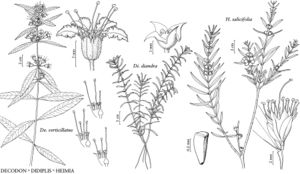Didiplis diandra
Amer. Bot. Fl., 124. 1870.
Leaves: blade 5–33 (–40) × 0.5–5 (–10) mm. Floral-tube 2 × 2 mm. Capsules globose, 1.5–2 × 1.5–2 mm. Seeds 0.6–0.7 × 0.2 mm. 2n = 32.
Phenology: Flowering late spring–fall.
Habitat: Shallow streams, margins of swamps and ponds, temporary pools, ditches, drying mudflats.
Elevation: 50–500 m.
Distribution
Ala., Ark., Fla., Ga., Ill., Ind., Iowa, Kans., Ky., La., Minn., Miss., Mo., Nebr., N.C., Tenn., Tex., Va., Wis.
Discussion
A Utah record is based on a specimen collected at Fish Lake, Sevier County, in 1894 (M. E. Jones 5781, BM) and on inclusion of the genus in the Utah flora without reference to a collection (I. Tidestrom 1925). Didiplis is not confirmed as a past or present member of that flora. Early reports of the species in Ohio by M. L. Fernald (1950) and others have not been verified (T. S. Cooperrider 1995). Didiplis diandra usually produces flowers and seeds underwater. Plants are often grown and sold internationally for the aquarium trade.
Ammannia nuttallii A. Gray, Didiplis linearis Rafinesque, Hypobrichia nuttallii Torrey & A. Gray, and Ptilina aquatica Nuttall ex Torrey & A. Gray are illegitimate names that pertain to D. diandra.
Selected References
None.
